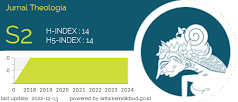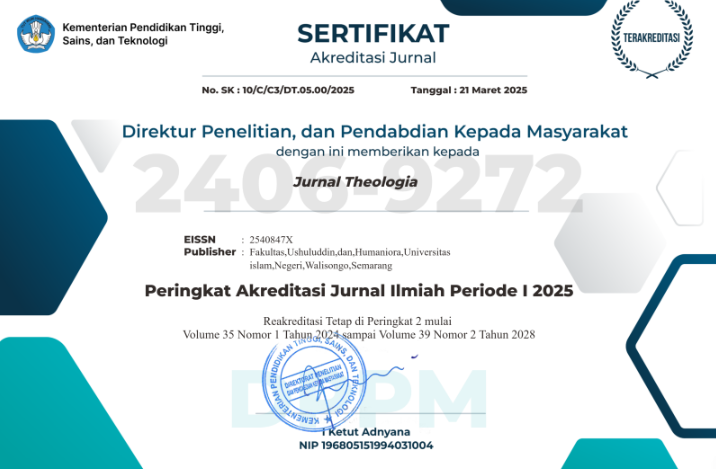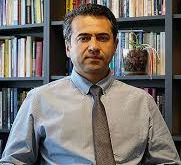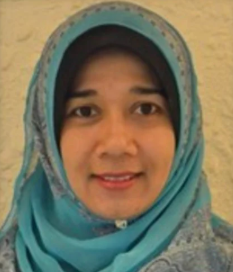Manuscript of Kitab Sifat Dua Puluh: The Portrait of Moderate Islamic Theological Doctrines from Interior Borneo
DOI:
https://doi.org/10.21580/teo.2020.31.2.6918Keywords:
Islamic theology, local genius, representation, Sufism, synthesis.Abstract
The construction of religious moderation is not only derived from the context of practices but also the texts of its theological doctrines. Manuscripts of Kitab Sifat Dua Puluh from West Kalimantan is a primary source to study the basis of Islamic religious moderation in Interior Borneo. The texts of the manuscript are no longer presented as a copy of al-Sanūsī’s Umm al-Barāhīn but it has become a corpus that accommodates local genius and tradition. This article aims to examine the moderation of Islamic theological doctrine derived from the texts of the manuscript of twenty attributes of God. The texts of a manuscript considered as one of the sustainable best practices of South-East Asian localisations of Islam because it was one of the basic references for the local Dayak Muslim community learning Islam in interior Boneo. This article is based on the results of philological studies on the manuscript collection written by Abang Ahmad Tahir (1860-1945) in Kapuas Hulu, West Kalimantan, Indonesia. The moderate Islamic theological doctrine in Abang Ahmad Tahir’s manuscript collection can be seen through three indicators namely the simplicity of the narrative articulation and arguments of the attributes of God, the synthesis of Islamic theological doctrine with Sufi doctrine, and the content of the text that gives no room for hate speech against local tradition and different systems of belief of the indigenous offspring of West Kalimantan.
Downloads
References
Abdullah, Irwan. Konstruksi Dan Reproduksi Kebudayaan. 3rd ed. Yogyakarta: Pustaka Pelajar, 2009.
Adams, Charles J. “Forward.” edited by Richard C. Martin. USA: The Arizona Board of Regents, 1985.
Amin, Ahmad. Ḍuḥā Al-Islām. Vol. 4. Beirut: Dar al-Fikr, 1969.
Amin, Faizal. Manuskrip Koleksi Abang Ahmad Tahir Kapuas Hulu: Kajian Teks Dan Parateks Tentang Konstruksi Identitas Dayak Islam Pada Awal Abad Ke-20. Edited by Mohammad Nor Ichwan. 1st ed. Semarang: Rasail Media Group, 2020.
Anonymous. Daqāiq Akhbār fi Dhikri al-Jannah wa-al-Nār A4 - Yunus Lungka, Ahmad bin Muhammad. Patani-Tailand: Matba’ah Halabi, n.d.
Feener, R Michael. “South-East Asian Localisations of Islam and Participation within a Global Umma, c. 1500–1800.” In The New Cambridge History of Islam, edited by Morgan. David O and Anthony Reid, Online., 470–503. Cambridge: Cambridge University Press, 2015. https://doi.org/http://dx.doi.org/10.1017/ CHOL9780521850315.
Gallop, Annabel Teh. “The Twenty Attributes of God in Malay: Sifat Dua Puluh.” The British Library: Asian and African studies blog, 2015. https://blogs.bl.uk/asian-and-african/2015/12/the-twenty-attributes-of-god-in-malay-sifat-dua-puluh.html.
Gallop, Annabel Teh, Wan Ali Wan Mamat, Ali Akbar, Vladimir Braginsky, Ampuan Hj Brahim bin A H Tengah, Ian Caldwell, Henri Chambert-Loir, et al. “A Jawi Source Book for The Study of Malay Paleography and Orthography.” Indonesia and the Malay World 43, no. 125 (2015): 13–171. https://doi.org/10.1080/ 13639811.2015.1008253.
Hermansyah, Erwin, and Rusdi Sulaiman. Islam Di Borneo: Jejak Tasawuf Dalam Naskah Muhammad As’ad Sambas. I. Pontianak: IAIN Pontianak Press, 2017.
Hodgson, Marshall G S. The Venture of Islam. Chicago: University of Chicago Press, 1974.
Kamal, Zainun. “Kekuatan Dan Kelemahan Faham Asy’ariyah Sebagai Doktrin Aqidah.” In Kontekstualisasi Doktrin Dalam Sejarah, edited by Budhy Munawar Rahman. Jakarta: Yayasan Waqaf Paramadina, 1994.
Kersten, Carool. A History of Islam in Indonesia: Unity in Diversity. Edinburgh: Edinburgh University Press, 2017.
Mahmuddin. “Pengaruh Faham Asy’ari Pada Pemikiran Masyarakat Tradisonal.” Al-Fikr: Jurnal Pemikiran Islam 21, no. 2 (2017): 69–76.
Malik, Mohd., Ade Unang, and Prayitno. Masuknya Islam Ke Kabupaten Kapuas Hulu. Putussibau: Departemen Agama Kabupaten Kapuas Hulu, 1985.
Mujiburrahman. “Islamic Theological Texts and Contexts in Banjarese Society: An Overview of the Existing Studies.” Southeast Asian Studies 3, no. 3 (2014): 611–41.
Nasr, Sayyed Hosein. Intelektual Islam Teologis, Filsafat Dan Gnosis. Yogyakarta: Pustaka Pelajar dan CIIS, 2009.
Purba, Juniar, and Yusriadi. Sejarah Kerajaan Silat Di Kabupaten Kapuas Hulu. Pontianak: STAIN Pontianak Press, 2013.
Rahman, A., Y. Ahmad, R. F. Anom, Muhadi, and Fahadi. Kabupaten Sambas: Sejarah Kesultanan Dan Pemerintah Daerah. Sambas: Dinas Pariwisata Pemda Kabupaten Sambas, 2001.
Ricklefs, Merle Calvin. Mystic Synthesis in Java: A History of Islamisation from the Fourteenth to the Early Nineteenth Centuries. 1st ed. Norwalk CT USA: EastBridge Signature Books, 2006.
Ricklefs, Merle Calvin, and Husni Syawie. Sejarah Indonesia Modern 1200-2004. 3rd ed. Jakarta: Serambi, n.d.
Syahzaman, Hasanuddin. Sintang Dalam Lintasan Sejarah. Pontianak: Romeo Grafika, 2003.
Tahir, Abang Ahmad C N - M S A A T 01. “Sifat Dua Puluh Semitau.” Putussibau, April 18, 1902.
Tahir, Abang Ahmad C N - M S A A T 02. “Penjelasan Sifat Dua Puluh.” Putussibau, April 18, 1904.
Tahir, Abang Ahmad C N - M S A A T 05. “Kitab Risalah Perukunan Islam.” Putussibau, April 18, 1921.




















